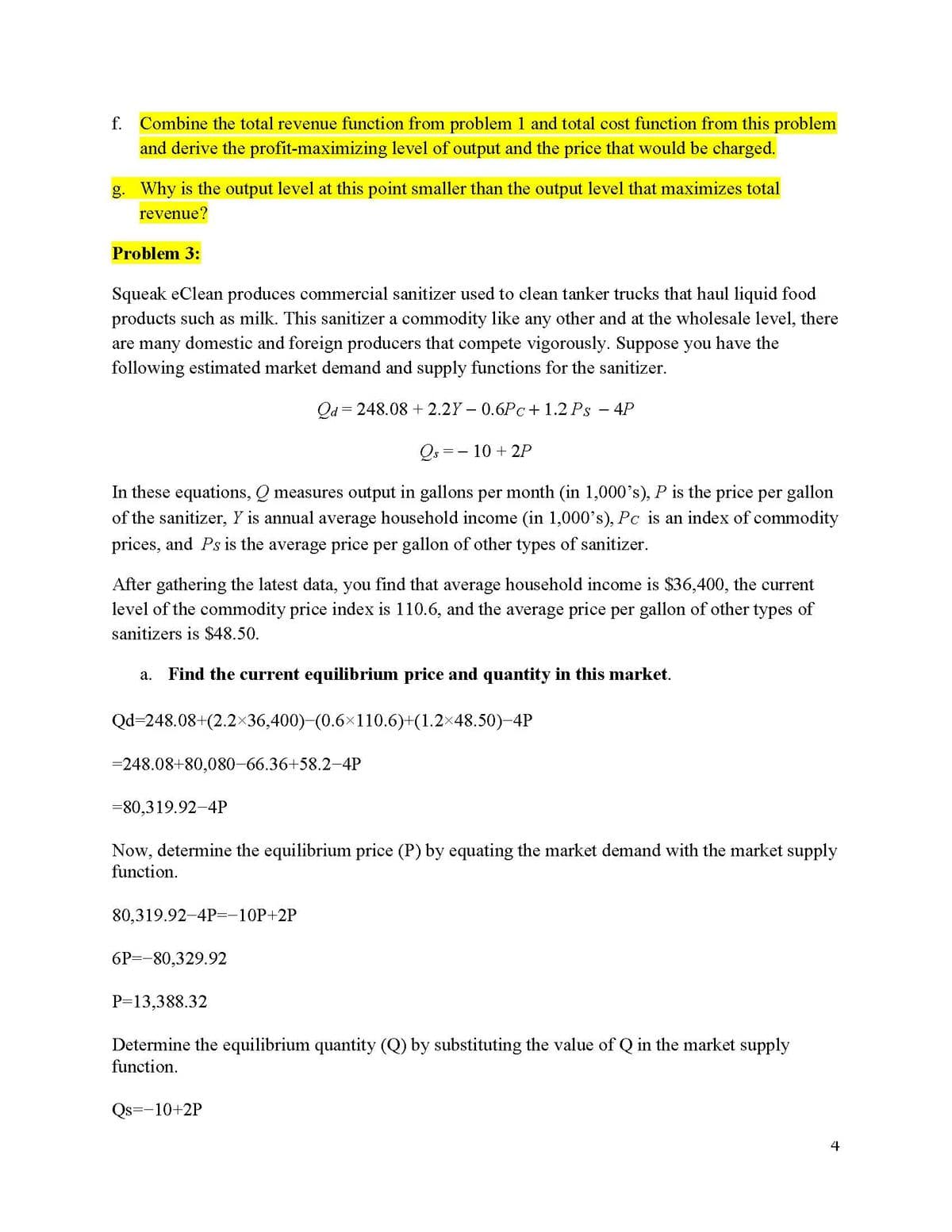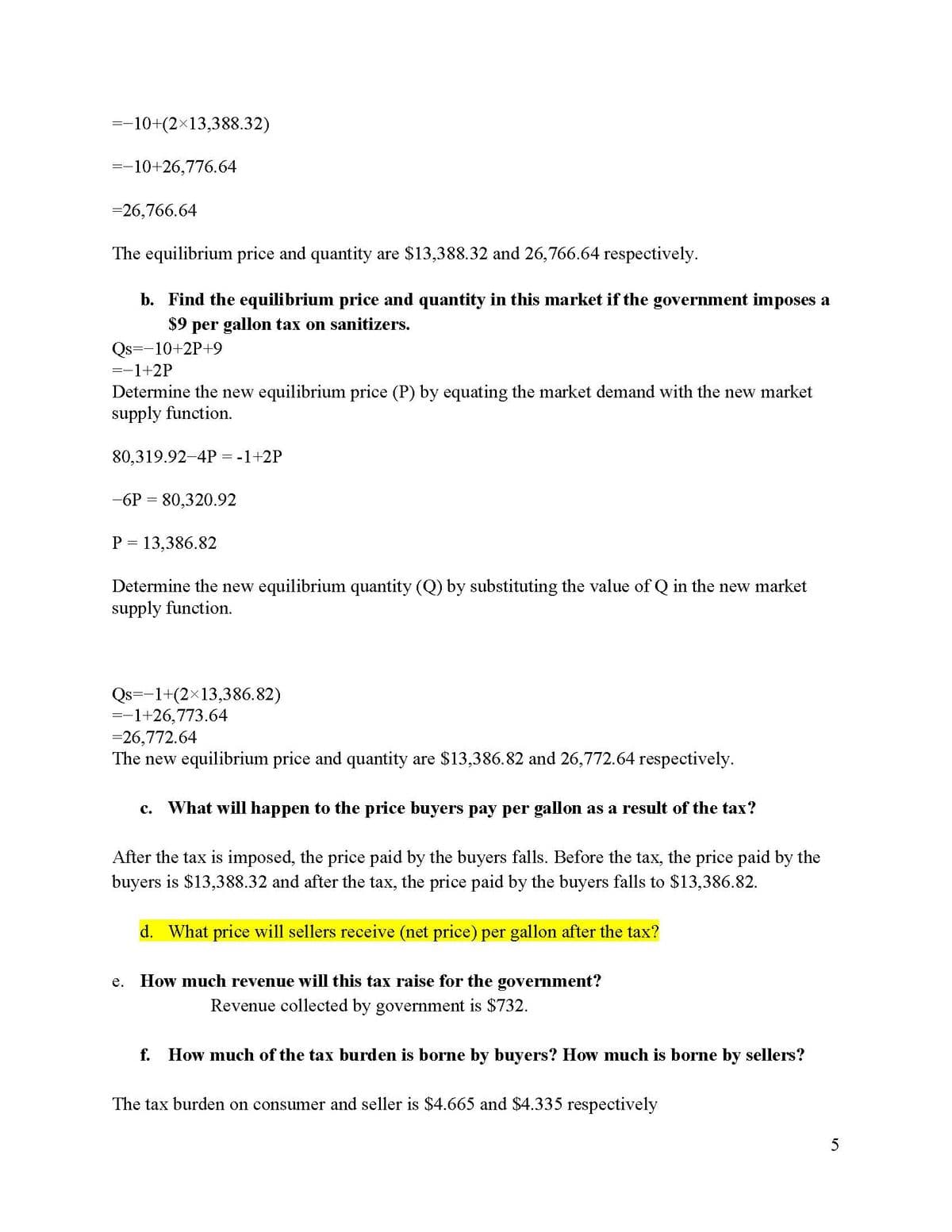e. d. What price will sellers receive (net price) per gallon after the tax? How much revenue will this tax raise for the government? Revenue collected by government is $732. f. How much of the tax burden is borne by buyers? How much is borne by sellers?
e. d. What price will sellers receive (net price) per gallon after the tax? How much revenue will this tax raise for the government? Revenue collected by government is $732. f. How much of the tax burden is borne by buyers? How much is borne by sellers?
Microeconomics: Private and Public Choice (MindTap Course List)
16th Edition
ISBN:9781305506893
Author:James D. Gwartney, Richard L. Stroup, Russell S. Sobel, David A. Macpherson
Publisher:James D. Gwartney, Richard L. Stroup, Russell S. Sobel, David A. Macpherson
Chapter9: Price Takers And The Competitive Process
Section: Chapter Questions
Problem 15CQ
Related questions
Question
Problem 3 and second attachment has highlighted question. Thanks

Transcribed Image Text:f. Combine the total revenue function from problem 1 and total cost function from this problem
and derive the profit-maximizing level of output and the price that would be charged.
g. Why is the output level at this point smaller than the output level that maximizes total
revenue?
Problem 3:
Squeak eClean produces commercial sanitizer used to clean tanker trucks that haul liquid food
products such as milk. This sanitizer a commodity like any other and at the wholesale level, there
are many domestic and foreign producers that compete vigorously. Suppose you have the
following estimated market demand and supply functions for the sanitizer.
Qd=248.08 +2.2Y-0.6Pc+1.2 Ps - 4P
Qs = 10 +2P
In these equations, Q measures output in gallons per month (in 1,000's), P is the price per gallon
of the sanitizer, Y is annual average household income (in 1,000's), Pc is an index of commodity
prices, and Ps is the average price per gallon of other types of sanitizer.
After gathering the latest data, you find that average household income is $36,400, the current
level of the commodity price index is 110.6, and the average price per gallon of other types of
sanitizers is $48.50.
a. Find the current equilibrium price and quantity in this market.
Qd=248.08+(2.2×36,400)-(0.6×110.6)+(1.2×48.50)-4P
=248.08+80,080-66.36+58.2-4P
-80,319.92-4P
Now, determine the equilibrium price (P) by equating the market demand with the market supply
function.
80,319.92-4P=-10P+2P
6P -80,329.92
P=13,388.32
Determine the equilibrium quantity (Q) by substituting the value of Q in the market supply
function.
Qs=-10+2P
4

Transcribed Image Text:=−10+(2×13,388.32)
=-10+26,776.64
=26,766.64
The equilibrium price and quantity are $13,388.32 and 26,766.64 respectively.
b. Find the equilibrium price and quantity in this market if the government imposes a
$9 per gallon tax on sanitizers.
Qs -10+2P+9
-1+2P
Determine the new equilibrium price (P) by equating the market demand with the new market
supply function.
80,319.92-4P = -1+2P
-6P = 80,320.92
P = 13,386.82
Determine the new equilibrium quantity (Q) by substituting the value of Q in the new market
supply function.
Qs -1+(2×13,386.82)
=-
=-1+26,773.64
=26,772.64
The new equilibrium price and quantity are $13,386.82 and 26,772.64 respectively.
c. What will happen to the price buyers pay per gallon as a result of the tax?
After the tax is imposed, the price paid by the buyers falls. Before the tax, the price paid by the
buyers is $13,388.32 and after the tax, the price paid by the buyers falls to $13,386.82.
d. What price will sellers receive (net price) per gallon after the tax?
e. How much revenue will this tax raise for the government?
Revenue collected by government is $732.
f. How much of the tax burden is borne by buyers? How much is borne by sellers?
The tax burden on consumer and seller is $4.665 and $4.335 respectively
5
Expert Solution
This question has been solved!
Explore an expertly crafted, step-by-step solution for a thorough understanding of key concepts.
This is a popular solution!
Trending now
This is a popular solution!
Step by step
Solved in 2 steps

Knowledge Booster
Learn more about
Need a deep-dive on the concept behind this application? Look no further. Learn more about this topic, economics and related others by exploring similar questions and additional content below.Recommended textbooks for you

Microeconomics: Private and Public Choice (MindTa…
Economics
ISBN:
9781305506893
Author:
James D. Gwartney, Richard L. Stroup, Russell S. Sobel, David A. Macpherson
Publisher:
Cengage Learning

Economics: Private and Public Choice (MindTap Cou…
Economics
ISBN:
9781305506725
Author:
James D. Gwartney, Richard L. Stroup, Russell S. Sobel, David A. Macpherson
Publisher:
Cengage Learning

Managerial Economics: Applications, Strategies an…
Economics
ISBN:
9781305506381
Author:
James R. McGuigan, R. Charles Moyer, Frederick H.deB. Harris
Publisher:
Cengage Learning

Microeconomics: Private and Public Choice (MindTa…
Economics
ISBN:
9781305506893
Author:
James D. Gwartney, Richard L. Stroup, Russell S. Sobel, David A. Macpherson
Publisher:
Cengage Learning

Economics: Private and Public Choice (MindTap Cou…
Economics
ISBN:
9781305506725
Author:
James D. Gwartney, Richard L. Stroup, Russell S. Sobel, David A. Macpherson
Publisher:
Cengage Learning

Managerial Economics: Applications, Strategies an…
Economics
ISBN:
9781305506381
Author:
James R. McGuigan, R. Charles Moyer, Frederick H.deB. Harris
Publisher:
Cengage Learning


Essentials of Economics (MindTap Course List)
Economics
ISBN:
9781337091992
Author:
N. Gregory Mankiw
Publisher:
Cengage Learning
